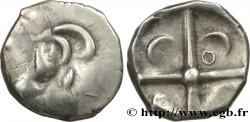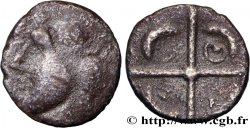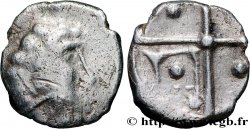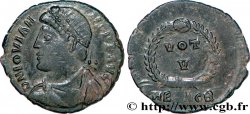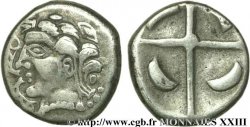v23_0734 - GALLIA - SUDOESTE DE LA GALLIA - LONGOSTALETES (Región de Narbonna) Drachme “au style languedocien”
MONNAIES 23 (2004)
Precio de inicio : 800.00 €
Valoración : 1 400.00 €
Precio realizado : 800.00 €
Número de ofertas : 1
Oferta más alta : 913.00 €
Precio de inicio : 800.00 €
Valoración : 1 400.00 €
Precio realizado : 800.00 €
Número de ofertas : 1
Oferta más alta : 913.00 €
Tipo : Drachme “au style languedocien”
Fecha: IIe siècle av. J.-C
Metal: plata
Diámetro: 15,5 mm
Eje de acuñación: 11 h.
Peso: 3,52 g.
Grado de rareza: R3
Comentarios sobre el estado de conservación:
Monnaie frappée sur un flan arrondi. Droit complet, revers complet mais légèrement décentré. Fine patine grise
Pedigrí:
Cet exemplaire est celui qui illustre le SAVÈS, Les monnaies gauloises à la croix, n° 335 (il fut acheté à M. Charra en décembre 1977) et provient du trésor de Béziers
Anverso
Titulatura del anverso: ANÉPIGRAPHE.
Descripción del anverso: Tête à gauche avec la chevelure à grosses mèches et tresses descendantes à plusieurs brins attachés en bas ; sourcil épais ; cou orné d'un collier de perles ; deux dauphins stylisés devant la bouche.
Reverso
Titulatura del reverso: ANÉPIGRAPHE.
Descripción del reverso: Croix bouletée au centre, formée de quatre cantons, chacun ornés d'une lunule.
Comentario
Selon G. Savès, ce type est "à rapprocher du type "cubiste" romanisé par son droit. N'est-ce pas plutôt le prototype, encore classique, des monnaies du type "cubiste"? En revanche, les dauphins sont particulièrement stylisés. Dans Moneta 28, cette monnaie est classée en "Rhoda 3e groupe" et datée de la fin du Troisième siècle avant J.-C. Les auteurs donnent d'ailleurs un poids de 3,75 grammes pour étayer leur datation, alors même que le poids moyen (des 25 exemplaires dont le poids est indiqué) est de 3,44 grammes, avec un écart allant de 2,46 à 4,41 grammes. Si certaines de ces monnaies datent effectivement de la fin du troisième siècle, l'assimilation excessive à partir des revers seuls peut devenir grotesque.
According to G. Savès, this type is \\\"to be compared to the \\\"cubist\\\" type romanized by its right. Is it not rather the prototype, still classical, of the coins of the \\\"cubist\\\" type? On the other hand, the dolphins are particularly stylized. In Moneta 28, this coin is classified in \\\"Rhoda 3rd group\\\" and dated to the end of the Third century BC. The authors also give a weight of 3.75 grams to support their dating, even though the average weight (of the 25 examples whose weight is indicated) is 3.44 grams, with a range ranging from 2.46 to 4.41 grams. If some of these coins do indeed date from the end of the third century, excessive assimilation based on the reverses alone can become grotesque.
According to G. Savès, this type is \\\"to be compared to the \\\"cubist\\\" type romanized by its right. Is it not rather the prototype, still classical, of the coins of the \\\"cubist\\\" type? On the other hand, the dolphins are particularly stylized. In Moneta 28, this coin is classified in \\\"Rhoda 3rd group\\\" and dated to the end of the Third century BC. The authors also give a weight of 3.75 grams to support their dating, even though the average weight (of the 25 examples whose weight is indicated) is 3.44 grams, with a range ranging from 2.46 to 4.41 grams. If some of these coins do indeed date from the end of the third century, excessive assimilation based on the reverses alone can become grotesque.








 Informar de un error
Informar de un error Imprimir la página
Imprimir la página Comparte mi selección
Comparte mi selección Haz una pregunta
Haz una pregunta Consignar / vender
Consignar / vender
 Descriptivo
Descriptivo